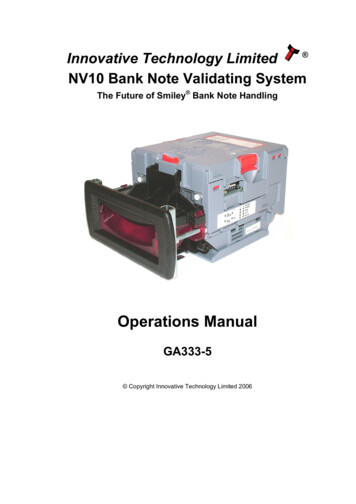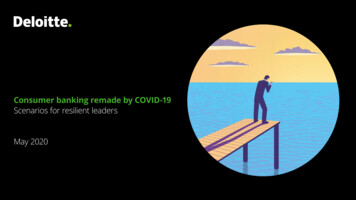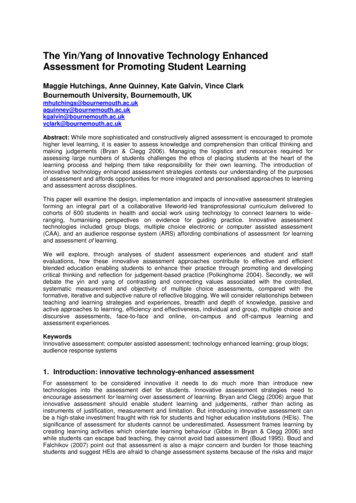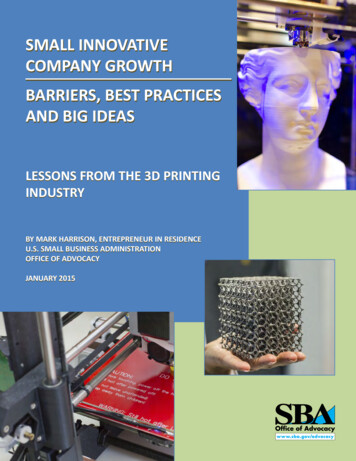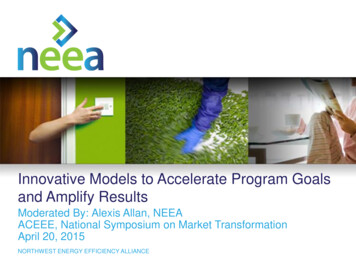
Transcription
Innovative Models to Accelerate Program Goalsand Amplify ResultsModerated By: Alexis Allan, NEEAACEEE, National Symposium on Market TransformationApril 20, 20151 NORTHWEST ENERGY EFFICIENCY ALLIANCE
Our Strategic Partners and FundersAccelerating energy efficiency in partnership with Northwest utilities2
What is Market Transformation ?Market transformation is the strategicprocess of intervening in a market to createlasting change 3
Your Guest Stars . Tim MichaelPacific Gas & Electric Company Peter BanwellUS Environmental Protection Agency Paul CampbellSears Holdings David HilbrichBest Buy4
5Making Energy EfficiencyIncentives More EffectiveTim MichelApril 21, 2015
Growing Miscellaneous Plug-loadEnergy UseChange in residential electricity consumptionper household (2012-40)Source: U.S. Energy Information Administration Annual Energy Outlook 20146
New Standards, Few Models.Diminishing Per Unit SavingsAugust 2014Over 200* CEE Tier 3 modelsAverage annual kWh savings 177Cost effective savings only justifya 10 to 25 rebateIncremental purchase pricein excess of 200March 2015Only 4* CEE Tier 3 modelsAverage annual kWh savings 73* 2 door models7
PLA Program TrendPG&E PLA Savings & Incentives120 25100 2080GWh 1560Million 1040 520Total GWhIncentives2010100 20201184 17201251 12201340 10201428 7 -Declining savings from PLA productportfolio8
Midstream Collaboration: NEEA, SMUD, PG&Eand More Estimated Energy Use by Size for New TVsWeighted Average Energy Use (Wats/TV)350325DesignActive engagementwith DOE and EPA300Launch250207200Total15010" to 39"108 40"8610063End50440All Major Retailers Participated9
Key Learnings From TV Pilot Collaboration Increases Participation New Evaluation Approaches Market Transformation10
Collaboration Increases ParticipationCoordinated Utility Incentives Streamlined Retailer Engagement Greater number of efficientproducts on store shelves More customers choose theefficient option Energy savings Market Impacts11
New Evaluation ApproachesTraditional ApproachMarket Transformation ApproachRich data from multiple sources: retailsales, manufacturers, EPA, DOEComparison Techniques Historical vs. Current Sales Forecast vs. Current Sales Participating vs. non-participating storesor regionsMarket Transformation Evidence Survey market participants and stores Interactions with DOE and EPA12
Market TransformationAlign energy efficiency programs with retailers’ business modelsWhich triggers structural changes in the marketplace toward energyefficiencySource: Northwest Energy EfficiencyAlliance, “NEEA’s Definition ofMarket Transformation”13
Midstream Program Development Collaborative efforts at PG&E, NEEA and SMUD todevelop midstream program that meets markettransformation objectives Coordinated 2014 Trials tested different programdesign variables. PG&E and SMUD Trial focused on a single retailer anda broad portfolio of products with a key objective toassess evaluation methodologies NEEA’s Trial, which included eight retailers and fourproducts, emphasized major program processes suchas product selection, data access and retailerengagement14
2014 PG&E and SMUD Trial Validate program operation, evaluation and performanceMarket Share of Qualified Appliances70%60%50%40%30%22 Participating Stores20%66 Non-Participating Stores10%0%Oct-14Nov-14Dec-14RPP Trial - Appliance Promotion 11/1-12/31/1415
2014 Key Milestones Retailers, Manufacturers and the EPA met withCalifornia Public Utility Commission EPA, under the ENERGY STAR brand, facilitated thestart of a nationally-coordinated, midstream, markettransformation platform Initial outreach to program sponsors, retailers, andmanufacturers at the ENERGY STAR partners’ meeting Panel discussion about midstream program innovationat the National Association of Regulatory UtilityCommissioners (NARUC)16
Why is Partnering Important?Scale Matters17
Why Scale Matters Greater impact over buying decisionsAdministration cost-sharingLower incentives overallImproved data collectionMarketing collaboration with the retailersMove the market further and faster!18
Retail Products Platform2015 Trial OverviewHome-Theaters-ina-Box/Sound Bars(ES 15%)Air CleanersDryersRoom Acs?Freezers19
Creating a More Energy Efficient Future forResidential CustomersThe ENERGY STAR Retail Products PlatformPeter BanwellACEEE/CEEWashington DC, April 21, 2015
A Message from the ENERGY STAR Retail Action Council(Scottsdale, AZ October 28, 2014) We support program sponsors efforts to build scale to be more effectiveand efficient via the ENERGY STAR Retail Products Platform. We believe this is the future of energy efficiency programs, and the futureis now! We are offering to help regulators recognize the energy savingopportunities. We are excited and wish to assist innovative Program Sponsors who jointogether with the EPA transform the energy efficiency market.
Process Task groupmeetings Standards Templates Programcoordination RetailerengagementPREPARATION VisionPilot plan–products, retailersParticipation expectationsBusiness caseDecisionmaker buy-inBudget estimatesAssemble teamIMPLEMENTATION ParticipationCommitmentENERGY STAR RPPPROCESS Gap Analysis Process Improvement Portfolio Changes ProgramLaunch MarketingField servicesData managementEnergy savings analysisPerformance dashboardIncentive payment MeasurementManufacturersENERGY STARRPP StakeholdersConsumersRetailersProgram Sponsors
Data Develop a consistent category sales datafeed from a retailer approved dataservices firmEnergy efficiency program sponsors willbe able to capture full program impact.Data categories include:– Model number– Date– Transaction identifier– Zip code / Store IDRFP for national data solutions company
Evaluation—A Different Approach is Required Currently under development among stakeholders and evaluation experts from CA,Northwest and Northeast regions. On-going communication with state regulators (NARUC) General agreement that evaluation methods need to have the followingcharacteristics:– Be considerably faster and less costly than current methods– Be based on indicators of shifts in the marketplace, using several data sources– Be sufficiently precise, but not as precise as traditional programs– Be based on a national data template provided by retailers, including regionaldata– Be a continuous ongoing and fluid process, rather than a traditional stop andstart process
2015/6 ProductsThe pilot was designed to Test a mix of different products Prove the program concept, and Streamline implementationThe pilot is currently limited to the following products: ENERGY STAR certified dryers– new category ENERGY STAR certified air cleaners– small unit sales,high per unit energy savings ENERGY STAR certified freezers– difficult to administercost effective downstream rebates ENERGY STAR certified sound bars ( 50%)– highgrowth category, limited per unit savings ENERGY STAR certified home theater systems–highgrowth category, limited per unit savings (for 2016) ENERGY STAR certified room airconditioners–revised specification, positioned to influencestocking plans for 2016
Who is Involved(as of April 2015)2015 Pilot SponsorsSponsors Developing Filings for 2016 DC SEU – DC BGE – MD Efficiency Vermont – VT DTE Energy – MI (2017) PG&E – CA (on behalf of SCE, SDGE, SoCalGas) PEPCO – MD SMUD – CA NJCEP – NJ SMECO – MD Eversource – CT UIL Holdings – CT Xcel – CO or MN (2017)2015 Participating Retailers Best Buy Sears Holdings The Home Depot2015 Other Key Stakeholders NRDC NEEP NEEAInterested Retailers CostcoNationwide Marketing GroupTargetWalmartOther Potential Pilot Sponsors Austin Energy – TXCape Light Compact – MAComEd – ILFirstEnergy Utilities – PA, MD, NJLADWP – CAMass Save – MANational Grid – MA & RINstar – MAOklahoma Gas Service – OKPECO – PAPSEG LI – NYTexas Gas Service – TX
Project UpdateWhat’s Next?What’s Being Worked On? EM&V: Development of guidelines andresource for 2015 pilot sponsors Pilot sponsors sign participation form by endof February 2015 Data: RFP for 2016 national programssolution, May 2015 results PGE & NEEA complete national data RFP(on behalf of all future participants) Products: Products for pilot programsconfirmed; begin development of frameworkfor product specification transitions Create framework for product specificationtransitions Continue developing national marketingstrategy Develop legal agreements Continue discussions at industry events Connect with ENERGY STAR Retail ActionCouncil members to discuss fieldservices/implementation overview document Launch 2015 pilot programs, continueplanning 2016 pilots Legal: Draft agreement between utilities andretailers for national program Marketing: Developed draft, look, and feel,based on current retailer guidelines Outreach: Discussions at industry events (e.g.CES, NEEP’s EM&V Forum, NARUC WinterMeetings) Field Services: Drafting overview documentand creating tool kit for sponsors Pilot Programs: Two “classes” 2015, 2016
Getting Started & ContactsGetting Started Contact EPA to discuss program concept and potential role Join the current team and develop a pilot Help shape discussions with regulators and evaluatorsContactsPeter BanwellBanwell.peter@epa.gov202-343-9408Hewan TomlinsonTomlinson.hewan@epa.gov202-343-9082
Retailer PerspectiveHugh Cherne – Best BuyPaul Campbell – Sears Holdings
Best Buy and Energy Star
US Retailers Tens of billions of annual customer contacts Over 4.7 trillion in annual sales 3.5% average net margin
Top 10 US Retailers Top 10 Applianceretailers have 83%market share Top 10 CE retailershave 79% marketshare Sell almost 2 billion energy consuming products that use 80million MWh per year
U.S. Retail – Macro Trends Shifting demographics Omni-channel shopping Personalization Brand loyalty Big data Security and privacy
YOUR SMARTER HOME STARTS HEREUpgrade your home with smartthermostats, locks, lighting, routersand appliances.
Intelligent Efficiency Integration Practical Connectivity fully demonstrated with physical space Simple presentation of both real world applications and user interfaces Technology reliant behavior defiant
Enhanced customer experience Seamless and personalized across all channels Quicker access to products and education Collaboration for program attribution
Retailers are the nexus of the value chainThousands of manufacturersMillions of customers These retailers have 70% share of Major Appliance market Critical partnerships with manufacturers
Current: Retailers assort product prior to Utility incentives are knownNew: Utilities (with scale), collaborate with retailersCustomers have more energy efficient choices!
Sears Holdings and Energy Star "Sears Holdings values our partnershipwith ENERGY STAR and is honored toreceive the Partner of the Year Award,"said William Hutchinson, Chief SupplyChain Officer, Sears Holdings. "We remain committed to continuingour work to help reduce greenhousegas emissions, increase energyefficiency and protect the environmentthrough our operational excellence,Kenmore product offerings andpartnerships with local utilities.”
Questions & Discussion As an energy efficiency community, whatspecific practices support growing andmaintaining successful long-term partnershipswith our market partners? What barriers and opportunities have beenidentified with these new approaches? What are the risks associated with midstreamprograms and how can the energy efficiencycommunity best mitigate these risks? What lessons have you learned that you wishyou’d known during design?40
US Environmental Protection Agency Paul Campbell Sears Holdings David Hilbrich Best Buy . 5 . DTE Energy -MI (2017) PEPCO -MD NJCEP -NJ SMECO - MD . Top 10 Appliance retailers have 83% market share Top 10 CE retailers have 79% market



